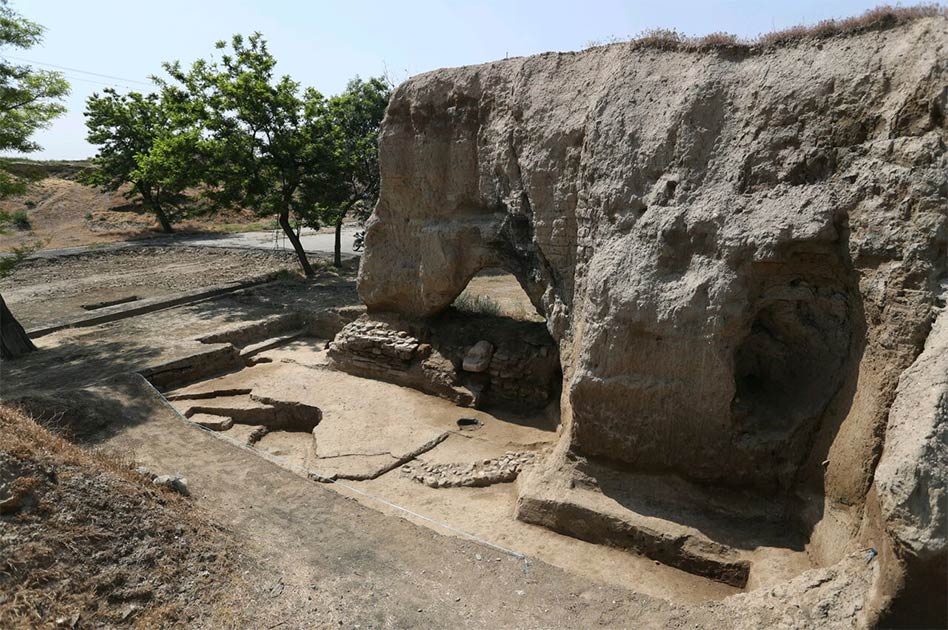New Digs Provide Insights into the Median Empire and Capital
The Median Empire and the Medes people are one of the most important in the ancient world. However, relatively little is known about them or their capital city, thought to be Ecbatana. Now, Iranian archaeologists believe they have made discoveries that can throw new light on this mysterious city and the Median Empire that was located in what is now Iran.
For several years Iranian archaeologists have been working on a hill known as Tepe Hegmataneh which is in the modern city of Hamadan in western Iran. This area has been excavated by European and American archaeologists since the early 20 th century. The most recent excavations were focused on finding out more about the mysterious Median capital of Ecbatana, which is widely believed to have once stood in this location.
The archaeologist Mehrdad Malekzadeh, who took part in the dig, is quoted by The Teheran Times as saying that ‘Hegmataneh hill is one of the most important archaeological sites [of ancient times] such as Rome, Athens, Alexandria and Babylon.’

Hegmataneh hill site where the new Iranian Median Empire discoveries were made (IRNA)
Rare Median Empire Discoveries Found in Hamadan
The Iranian team were investigating the geology of the Hegmataneh hill, especially its lowest layers. These layers yielded finds related to an ancient fortress and settlement that once stood there. The archaeologists focused their investigations on an area known as the ‘Camel’s Hole’, and at a depth of 9 feet (3m) they found the remains of a stone wall. Malekzadeh told The Teheran Times that ‘we have discovered relatively satisfying signs of Median architecture and pottery’. The artifacts and structures that were found were at a much lower level than anything previously discovered.
These new discoveries are potentially among the few identifiable Median Empire remains ever uncovered. Therefore, the structures and artifacts that have been unearthed recently are extremely important. Carbon dating, and other testing, is expected to confirm that the items uncovered in the lowest layers of the hill are Median. These findings are likely connected to the earliest history of Ecbatana and the Iranian Median Empire.

Archaeologists at work on Hegmataneh hill where the new Iranian Median Empire discoveries were made (IRNA)
The Empire of the Medes
The Medes were an Iranian-speaking people and they lived in what is now north-west Iran and Azerbaijan. Sometime in the 7 th century BC, Deioces, son of Phraortes, united all the Median tribes. He is considered the founder of the Median capital of Ecbatana. His grandson Cyaxares, in alliance with the Babylonians, attacked the mighty Assyrian Empire, the superpower in the Near East at the time. The Cyaxares-Babylonian coalition destroyed the Assyrian Empire.
The Medes established their extensive empire in what is now Azerbaijan and north-western Iran. However, in 550 BC, they were defeated by their former subjects the Persians and their king Cyrus the Great. But the Medes retained an important role with the new Achaemenid kings that followed their defeat by the Persians. According to Encyclopedia Britannia, ‘they retained a prominent position; in honour and war they stood next to the Persians, and their court ceremonial was adopted by the new sovereigns.’ After the conquest of the Achaemenid Empire by Alexander the Great, Media became an important surrogate or satrap in Alexander’s empire.
- Kings of the Umman Manda (Media): Warnings and Omens – Part II
- Achaemenid Religion: Lighting the Spirit of Ancient Persia
- Satraps of the Persian Empire – Rebellious Protectors of the Realm
A number of Greek historians have written about the Iranian Median capital of Ecbatana. From their writings we know Ecbatana was situated on a hill and was enclosed within several concentric walls, and that some of the walls were overlaid with silver and gold. The Greek historian Polybius stated that ‘the city was richer and more beautiful than all other cities in the world’ according to The Tehran Times. He also wrote that the palace of the Median kings was unwalled, and located on a terrace and much of it was covered in silver and gold.
Ecbatana remained an important city even after the fall of the Iranian Median Empire. It is believed to have been the summer capital of the Achaemenids. Even after the sacking of the city and the palace by Alexander the Great, it remained a magnificent city. Later, it served as one of the capitals of the Seleucid Empire. And after the fall of the Seleucids, Parthian Empire kings often resided in the city of Ecbatana.
Despite the recent discoveries, there are many remaining mysteries and unanswered questions. The latest finds may offer new insights into the history of Ecbatana but according to The Tehran Times, it is still ‘a riddle, wrapped in a mystery’. Further investigations at the site in the coming years will hopefully add more to our understanding of this important city and the Iranian Median Empire.
Top image: Hegmataneh hill, Hamadan City, Iran, where the new Iranian Median Empire discoveries were made Source: IRNA
By Ed Whelan

















